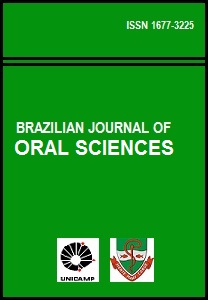Abstract
Surface electromyography has been a useful tool for physicians and investigators to evaluate and diagnose temporomandibular disorders, to examine the role of masticatory muscles in specific tasks, and to verify the effect of therapeutic resources in temporomandibular disorders patients. However, the lack of standardization of the methods and equipment used during the surface electromyography examination has been the target of criticism among researchers. The purpose of this article is to describe the materials, equipment and surface electromyography protocol used to evaluate temporomandibular disorders patients at the Piracicaba Dental School - University of Campinas –Brazil. This experimental protocol is used successfully in the majority of cases seen in Electromyography Laboratory at Piracicaba Dental School.References
Bevilaqua-Grosso D, Monteiro-Pedro V, Guirro RRJ, Berzin, F. A physiotherapeutic approach to craniomandibular disorders: a case report. J Oral Rehabil. 2002; 29: 268-73.
Biasotto DA. Estudo da eficácia da técnica fisioterápica (massoterapia) em indivíduos portadores de DTM miogênica, frendor através da eletromiografia pré e pós-tratamento [thesis]. Piracicaba: FOP/UNICAMP; 2002.
Kamyszek G, Ketcham R, Garcia RJr, Radke J.
Electromyographic Evidence of reduced muscle activity when ULF-TENS is applied to the Vth and VIIth cranial nerves. Cranio. 2001; 19: 162-8.
Rodrigues DR Efeito da estimulação elétrica nervosa transcutânea sobre a atividade eletromiográfica dos músculos da mastigação em indivíduos portadores de desordem temporomandibular [thesis]. Piracicaba: FOP/UNICAMP; 2002.
Avila AOV, Amadio AC, Guimarães ACS, David AC, Mota CB, Borges DM et al. Métodos de medição em biomecânica do esporte: descrição de protocolos para aplicação nos centros de excelência esportiva. Braz J Biomech. 2002; 3: 57-67.
Merletti R. The standards for reporting EMG data. J Electromyogr Kinesiol.1999; 9: 1.
Dahlström L. Electromyographic studies of craniomandibular disorders: a review of the literature. J Oral Rehabil. 1989;16: 1- 20.
Lous I, Sheikholeslam A, Moller E. Postural activity in subjects with functional disorders of the chewing apparatus. Scand J Dent Res. 1970; 78: 404-10.
Carlson CR, Okeson JP, Falace DA, Nitz AJ, Anderson D. Stretch based relaxation and reduction of EMG activity among masticatory muscle pain patients. J Craniomandib Disord. 1991; 5: 205-12.
Naeije M, Hansson TL. Eletromyographic screening of myogenous and arthrogenous TMJ dysfunction patients. J Oral Rehabil. 1986; 13: 433-41.
Pinho JC, Caldas FM, Mora MJ, Santana-Penin U. Electromyographic activity in patients with temporomandibular disorders. J Oral Rehabil. 2000; 27: 985-90.
Ayub E, Glasheen-Wray M, Kraus S. Head posture: a case study of the effects on the rest position of the mandibule. J Orthop Sports Phys Ther. 1984; 5: 179-83.
Mclean LF, Brenman HS, Friedman MGF. Effects of changing body position on dental occlusion. J Prosthetic Dent. 1973; 52: 1041-5.
Goldstein DF, Kraus SL, Williams WB, Glasheen-Wray M. Influence of cervical posture on mandibular movement. J Prosthetic Dent. 1984; 52: 421-6.
Zuniga C, Miralles R, Mena B, Montt R, Moran D, Santander H et al. Influence of variation in jaw posture on sternocleidomastoid and trapezius electromyographic activity.Cranio. 1995; 13: 157-62.
Al-Saad M, Akeel MR. EMG and pain severity evaluation in patients with TMD using two different occlusal devices. Int J Prosthodont. 2001; 14: 15-21.
. Cooper BC. The role of bioelectronic instrumentation in the documentation and management of temporomandibular disorders. Oral Surg Oral Med Oral Pathol Oral Radiol Endod. 1997; 83: 91-100.
Valentino B, Aldi B, Melito F, Valentino T. An EMG study on TMJ disorders. Int Rech Sci Stomatol Odontol. 2002; 44: 14-8.
Ferrario VF, Sforza C, Tartaglia GM, Dellavia C. Immediate effect of a stabilization splint on masticatory muscle activity in temporomandibular disorder patients. J Oral Rehabil. 2002; 29: 810-5.
Hersek N, Uzun G, Cindas A, Canay S, Kutsal YG. Effect of anterior repositioning splints on the electromyographic activities of masseter and anterior temporalis muscles. Cranio.1998; 16: 11-6.
. Treacy K. Awareness/relaxation training and transcutaneous electrical neural stimulation in the treatment of bruxism. J Oral Rehabil. 1999; 26: 280-7.
Cram JR, Kasman GS. Introduction to Surface Electromyography. Gaithersburg, Aspen Publishers; 1998. 408p.
Biasotto DA. Estudo eletromiográfico dos músculos do sistema estomatognático durante a mastigação de diferentes materiais [dissertation]. Piracicaba: FOP/UNICAMP; 2000.
The Brazilian Journal of Oral Sciences uses the Creative Commons license (CC), thus preserving the integrity of the articles in an open access environment.

